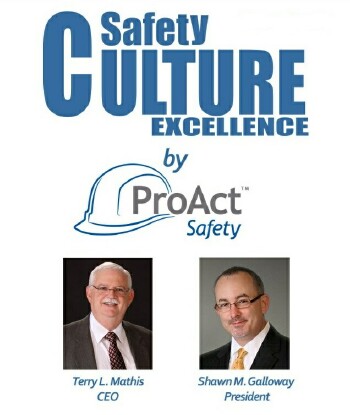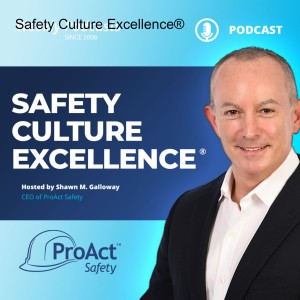Episodes

Wednesday Jun 17, 2015
Confrontational Thinking
Wednesday Jun 17, 2015
Wednesday Jun 17, 2015
It is incredible to me how tenaciously old thinking clings to the safety community. I continue to hear pundits assert that confrontation is a key skill of creating a safety culture. Unless you want a confrontational culture, I couldn’t disagree more if they were twice as wrong. So, why do you not want to make confrontation a common skill and a key part of your culture? Because confrontation is a “stopping tool.” If you cling to the old idea that safety is getting workers to “stop taking risks,” then you tend to think this way. Workers get hurt because they take risks. “Workers are the problem with safety. Fix the workers and you will fix safety.”
However, if you can grasp the concept that workers don’t want to get hurt and that they are the customers of your safety programs, then you will think differently. Accidents happen because of risks. Safety needs to help management identify and remove or reduce risks where possible. Safety needs to help workers identify and deal with remaining risks efficiently. Workers need to help each other practice taking precautions around the remaining risks. The key skill of safety is coaching, not confronting. Safety is about starting excellence, not stopping stupid risk taking.
If you continue to think the about safety the way you always have, you will do as you have always done and produce the same results you always have. Get away from confrontational thinking and embrace the concepts of safety excellence.
-Terry L. Mathis
For more insights, visit
www.ProActSafety.com
Terry L. Mathis is the founder and CEO of ProAct Safety, an international safety and performance excellence firm. He is known for his dynamic presentations in the fields of behavioral and cultural safety, leadership, and operational performance, and is a regular speaker at ASSE, NSC, and numerous company and industry conferences. EHS Today listed Terry as a Safety Guru in ‘The 50 People Who Most Influenced EHS three consecutive times. He has been a frequent contributor to industry magazines for over 15 years and is the coauthor of STEPS to Safety Culture Excellence (2013, WILEY).


Wednesday Jun 03, 2015
Seeing the Whites of Their Eyes
Wednesday Jun 03, 2015
Wednesday Jun 03, 2015
Have you ever looked into the eyes of workers in a safety meeting? In some meetings the eyes light up, in some they gloss over, and in others they roll. If you are creating gloss and/or rolling eyes, you have a great opportunity! Think about it - you already dedicate time to safety meetings. Why not get the maximum return for that time invested?
I know a lot of meetings are mandatory. I know that being forced to do something can take the fun and motivation out of it. But it doesn’t have to be a boring case of grudging compliance. Meetings can be an opportunity to discuss upcoming issues, share expertise from experienced hands to new hires, discuss best practices, or plan an upcoming project. It doesn’t have to be a lecture or sermon on thinking before you act. It can be interactive and engaging with just a little effort and pre-planning.
The key aspects to creating bright-eyed meetings are practicality and participation. Topics that don’t readily apply to real work get eyes rolling. Boring speech-giving presenters or shallow attempts to involve workers make the eyes gloss over. Remember this formula: Practical topics + Engaging delivery = Bright eyes.
-Terry L. Mathis
For more insights, visit
www.ProActSafety.com
Terry L. Mathis is the founder and CEO of ProAct Safety, an international safety and performance excellence firm. He is known for his dynamic presentations in the fields of behavioral and cultural safety, leadership, and operational performance, and is a regular speaker at ASSE, NSC, and numerous company and industry conferences. EHS Today listed Terry as a Safety Guru in ‘The 50 People Who Most Influenced EHS three consecutive times. He has been a frequent contributor to industry magazines for over 15 years and is the coauthor of STEPS to Safety Culture Excellence (2013, WILEY).


Wednesday May 27, 2015
Pipeline Industry's Stance to Improve Reputation
Wednesday May 27, 2015
Wednesday May 27, 2015
The Huffington Post article, “America’s Disastrous History of Pipeline Accidents Shows Why the Keystone Vote Matters” highlighted the pipeline industry’s incident record and stated that on average one significant pipeline incident occurs in the country every 30 hours. The key question to ask is – what is the pipeline industry doing to reduce the number of incidents and lower the risk of harm to the environment and surrounding communities where they operate.
After the 2010 San Bruno pipeline explosion in California and per National Transportation Safety Board’s recommendations, midstream industry leaders in coordination with the American Petroleum Institute (API) gathered and collaborated to develop a recommended practice (RP) for the industry. Known as, API RP 1173 Pipeline Safety Management System (PSMS), it provides guidance for developing and maintaining a comprehensive management system to improve operational safety and decrease the rate of releases and incidents. The PSMS framework defined in API 1173 shares common principles with safety management systems found in other industries such as nuclear, aviation, offshore oil and gas, and refinery and chemical plants. These safety management programs have demonstrated reductions in operational risk, reduced occurrences of incidents, and provided a platform for continuous improvement to achieve operational excellence. Large, integrated energy companies already have such overarching management systems in place that cover pipeline safety, such as an operations management system. However, the standards in API RP 1173 will likely require effort and executive commitment to enhance existing operations management/safety management system to fully meet the API RP 1173 requirements.
While many midstream companies have various programs that address risk management, asset integrity and management of change, a safety management system will provide an integrated management system that cuts through organizational and functional silos to achieve greater transparency and awareness which leads to better decision making and safer operations. Recognizing the significance of leadership accountability and communications to achieve a sustainable and meaningful operations/safety management system, the API RP 1173 devotes significant content to framing the role leadership at all levels plays in ensuring safe and reliable operations.
The final release of API RP 1173 is anticipated next month and is expected to change the way leaders think about their business decisions to a more holistic, systematic approach. For example, the draft version of API RP 1173 states, “Managing the safety of a complex process, as well as simpler systems, requires coordinated actions to address multiple, dynamic activities and circumstances. Pursuing the industry-wide goal of zero incidents requires comprehensive, systematic effort. While process-related incidents are relatively infrequent but can lead to serious consequences.”
While not mandatory to adopt API RP 1173, an operator risks being found negligent for not adopting and following a PSMS consistent with RP 1173 in the event of an incident as it will be considered an industry standard for which pipeline operators to follow.
This has been a guest contribution by Katherine Molly.
 Katherine, Principal of Northhighland, works with executive management and project teams to improve organization processes for safety and reliability, reduce capital program and business process risks, and resolve program/ project crisis and disputes in the energy industries. Supporting owners, contractors, engineers, their legal counsel and sureties, she has led assessment and improvement organization and project programs, enhanced project execution, coalesced conflicting parties, and participated in the settlement/litigation of business and project disputes ranging from $1 million to multi-billion dollars.
Katherine, Principal of Northhighland, works with executive management and project teams to improve organization processes for safety and reliability, reduce capital program and business process risks, and resolve program/ project crisis and disputes in the energy industries. Supporting owners, contractors, engineers, their legal counsel and sureties, she has led assessment and improvement organization and project programs, enhanced project execution, coalesced conflicting parties, and participated in the settlement/litigation of business and project disputes ranging from $1 million to multi-billion dollars.
Wednesday May 20, 2015
De-mystifying Safety
Wednesday May 20, 2015
Wednesday May 20, 2015
It is amazing how many workers view safety as a form of Voodoo. They know they can do a job hundreds of times accident-free, then suddenly get injured. What is the difference, and how can you prevent such random events?
To begin de-mystifying safety, you must first define it. Safety has three parts: 1. Identifying and recognizing risks, 2. Addressing risks through conditional changes or behavioral precautions, and 3. Developing consistency in risk control. In short, workers have to know what can hurt them, know how to keep these things from hurting them, and consistently do those things.
Internalizing such a definition tends to take the mysticism out of safety. Each time an accident happens, workers analyze which of the three steps didn’t happen, and understand the causation of accidents. There is no Voodoo, only cause-and-effect.
-Terry L. Mathis
For more insights, visit
www.ProActSafety.com
Terry L. Mathis is the founder and CEO of ProAct Safety, an international safety and performance excellence firm. He is known for his dynamic presentations in the fields of behavioral and cultural safety, leadership, and operational performance, and is a regular speaker at ASSE, NSC, and numerous company and industry conferences. EHS Today listed Terry as a Safety Guru in ‘The 50 People Who Most Influenced EHS three consecutive times. He has been a frequent contributor to industry magazines for over 15 years and is the coauthor of STEPS to Safety Culture Excellence (2013, WILEY).


Wednesday May 13, 2015
Self-Awareness: The Short-Cut to Greatness
Wednesday May 13, 2015
Wednesday May 13, 2015
Since the beginning of time, successful people around the world have shared similar personality characteristics.
Martin Luther King inspired a movement with his ability to instill emotion in his fellow people. Winston Churchill made a war-torn nation stand up with confidence and fight a seemingly unstoppable enemy. Mahatma Ghandi used civil disobedience to change the world for Indians, at home and in South Africa. Steve Jobs inspired a technological revolution with creativity and an uncanny knack for capturing an audience.
Behavioral science will tell you that these great people had specific personality characteristics that led them to behave in the way they did. Research into psychology and personality will provide evidence that they were great because they were born great.
But what about the rest of us?
Chances are, you may consider yourself a bit more “ordinary” than the leaders of history. However, you have the potential to achieve your own personal greatness.
Through self-awareness, we can learn how to interrupt our natural default behaviors that keep us from behaving in a way that is productive, efficient, and safe. By taking control of our own self-awareness and truly understanding who we are underneath it all, we can achieve our own greatness in our own lives. The only thing holding us back is ourselves.
Take one of my friends for instance. He was not a social person by birth; he has consciously developed the skills of communication and education to a point that those who meet him would describe him as a talkative and very pleasant person. Little do they know that he exerts a significant amount of energy in social situations - far less than people like him who naturally derives great pleasure from social interaction.
How did he do it? Through a heightened sense of self-awareness.
If my friend recognized that he was uncomfortable in a situation, he would remind himself of why it’s important that he develops these skills. In times of stress or confusion, when his natural default personality was at its strongest, he learned to be in control, behave in the way he wanted to, and ignore his sometimes risky gut reactions.
You too can rise to new heights by first learning why you act the way you do. Through this self-reflection you can leverage your innate strengths to improve your decision making and behavior both at work and at home.
This has been a guest contribution by Greg Ford.
 Greg is the co-founder and CEO
of TalentClick Workforce Solutions
and an adjunct professor at Simon Fraser University in Vancouver, Canada. Greg
holds a degree in Psychology and a Master’s degree in Workplace Learning. He is
the co-author of the safety book “Before It Happens” and has spoken at conferences
across North America.
Greg is the co-founder and CEO
of TalentClick Workforce Solutions
and an adjunct professor at Simon Fraser University in Vancouver, Canada. Greg
holds a degree in Psychology and a Master’s degree in Workplace Learning. He is
the co-author of the safety book “Before It Happens” and has spoken at conferences
across North America.
You can discover the power of Safety Self-Awareness with a free 30 day unlimited subscription of TalentClick’s full suite of safety solutions, including self-study, online training, and personalized coaching by going to http://www.talentclick.com/gb-trial/.

Wednesday May 06, 2015
Humans are Risk Takers
Wednesday May 06, 2015
Wednesday May 06, 2015
Human nature involves risk taking; every human takes calculated risks on a daily basis. Safety is about removing risks, and thus competes with human nature. We can address this by trying to change human nature or by increasing the capacity to calculate risks more accurately. Very few people know even the approximate probability of the risks they take or which risks are more likely to result in an accidental injury.
Organizations should analyze their accident data, not by body part most injured or injury category most common, but by which precaution has the potential to prevent the most injuries. This data should be methodically shared with every employee to shape their perceptions of risks and focus their safety activities. If this does not happen, individual perceptions of risks will vary by personal experience and knowledge of accident data, and will not result in maximum focus and directed effort.
-Terry L. Mathis
For more insights, visit
www.ProActSafety.com
Terry L. Mathis is the founder and CEO of ProAct Safety, an international safety and performance excellence firm. He is known for his dynamic presentations in the fields of behavioral and cultural safety, leadership, and operational performance, and is a regular speaker at ASSE, NSC, and numerous company and industry conferences. EHS Today listed Terry as a Safety Guru in ‘The 50 People Who Most Influenced EHS three consecutive times. He has been a frequent contributor to industry magazines for over 15 years and is the coauthor of STEPS to Safety Culture Excellence (2013, WILEY).


Wednesday Apr 29, 2015
Peeling the Onion: Solving Safety Problems One Layer at a Time
Wednesday Apr 29, 2015
Wednesday Apr 29, 2015
During a safety observation, workers were observed using the wrong tool for a job, which created a risk. When a safety committee saw the report, they petitioned management to buy the proper tool for the work station. The committee member who received the tool took it to the work station and presented it to the worker on shift with an explanation of what had happened and the action taken. The worker admitted that he really had not been taught what the proper tool was for the job and had used the home-made tool since he began his job.
The next month’s observations reported that workers were still using the wrong tool for the job. Follow-up revealed that workers on the other shifts had not received the communication and were not aware of the new tool. The safety committee made sure that every worker was made aware of the proper tool in safety and tool box meetings and felt sure the next month’s data would show the problem solved.
The next month, the observations showed the workers were STILL not using the right tool. Follow-up revealed that workers had formed the habit of using the wrong tool and that the habit was not changed. The safety committee developed a plan to remind workers and, within the next few months, the problem was truly solved.
Lessons learned:
• Safety problems can be multi-layered and require multiple fixes.
• Solving problems requires follow-up.
• Influences need to be addressed in order to change the behavior.
-Terry L. Mathis
For more insights, visit
www.ProActSafety.com
Terry L. Mathis is the founder and CEO of ProAct Safety, an international safety and performance excellence firm. He is known for his dynamic presentations in the fields of behavioral and cultural safety, leadership, and operational performance, and is a regular speaker at ASSE, NSC, and numerous company and industry conferences. EHS Today listed Terry as a Safety Guru in ‘The 50 People Who Most Influenced EHS three consecutive times. He has been a frequent contributor to industry magazines for over 15 years and is the coauthor of STEPS to Safety Culture Excellence (2013, WILEY).

Wednesday Apr 22, 2015
Factor-Finding Failures
Wednesday Apr 22, 2015
Wednesday Apr 22, 2015
When new safety programs or processes are rolled out unsuccessfully, there has almost always been a failure to determine either the factors necessary for success, the factors that can contribute to failure, or some combination of both. Without a list of the key factors of success and failure, a project launch is a blind affair. This blindness seems more logical if the project appears to be well constructed and has been successful at other organizations or sites in the same organization. Sadly, imitation of success is no guarantee of success.
The reasons for the imitation failing are basically the differences in sites and cultures. A good fit for one site might be a recipe for disaster at another. That is why an analysis of success and failure factors is so necessary. Such an analysis is unique to each culture. It should include a review of past successes and/or failures and the factors that contributed to those; but it should also include simply asking a representative cross-sample of people what they think of the project and what it would take to make it work. Good implementers and change agents have usually learned a lot about such analysis, but can almost always be more thorough if they simply list critical factors to success and failure, and address them in their implementations.
-Terry L. Mathis
For more insights, visit www.ProActSafety.com
Terry L. Mathis is the founder and CEO of ProAct Safety, an international safety and performance excellence firm. He is known for his dynamic presentations in the fields of behavioral and cultural safety, leadership, and operational performance, and is a regular speaker at ASSE, NSC, and numerous company and industry conferences. EHS Today listed Terry as a Safety Guru in ‘The 50 People Who Most Influenced EHS three consecutive times. He has been a frequent contributor to industry magazines for over 15 years and is the coauthor of STEPS to Safety Culture Excellence (2013, WILEY).

Wednesday Apr 15, 2015
How OSHA Damaged Safety Training
Wednesday Apr 15, 2015
Wednesday Apr 15, 2015
When OSHA set quantity requirements for annual refresher training without setting stringent quality requirements, safety training began a never-ending downward spiral. The vast majority of ALL safety training, OSHA required and otherwise, is low-quality training that has little to no impact on performance in the workplace. This was certainly not the intention or the fault of OSHA, but they started the movement and have yet to do anything to stop it.
After interviewing tens of thousands of workers, we seldom find any who truly value safety training. There are exceptions, and some are quite innovative and effective; but they are in the minority. Most safety training is boring and repetitious. It is to be endured rather than relished. It is demotivating and sometimes even demeaning.
But this is not a characteristic of training in general; only of safety training. It does not have to be so. Safety training can be stimulating and thought expanding. It can establish focus and help to address specific issues. It can build effective cultures and foster teamwork. Often, the amount of effort and resources needed to turn boring training into dynamic training is well worth the effort. Organizations should seek to maximize the impact of their safety training rather than just keeping the organization in minimum regulatory compliance.
-Terry L. Mathis
For more insights, visit
Terry L. Mathis is the founder and CEO of ProAct Safety, an international safety and performance excellence firm. He is known for his dynamic presentations in the fields of behavioral and cultural safety, leadership, and operational performance, and is a regular speaker at ASSE, NSC, and numerous company and industry conferences. EHS Today listed Terry as a Safety Guru in ‘The 50 People Who Most Influenced EHS three consecutive times. He has been a frequent contributor to industry magazines for over 15 years and is the coauthor of STEPS to Safety Culture Excellence (2013, WILEY).


Wednesday Apr 08, 2015
Training vs. Education
Wednesday Apr 08, 2015
Wednesday Apr 08, 2015
More and more organizations are using computer-based training (CBT) modules. Most started using them for OSHA-required yearly refresher training. The CBT approach had some advantages: workers could attend individually rather than in a classroom with multiple students and an instructor; the individual training approach caused less disruption of business activities than a classroom approach; the training was self-paced so everyone could move through the materials at their own pace; the modules could include testing for knowledge levels; and the CBT could keep current rosters of who had completed the various modules.
Then organizations expanded the use of CBT into more questionable areas. Along this path, someone forgot that CBT is education; not training. You can impart information via computer but you cannot build manual skills. Relying on CBT to teach manual job skills or even basics such as fire-extinguisher use is only a partial approach. Students end up having knowledge without skills. If the CBTs are followed up with on-the-job training or classroom simulations, the knowledge can begin to be translated into skills. Without such follow-up, CBTs can simply create a false sense of competence that can, and has, resulted in serious safety incidents.
-Terry L. Mathis
For more insights, visit
www.ProActSafety.com
Terry L. Mathis is the founder and CEO of ProAct Safety, an international safety and performance excellence firm. He is known for his dynamic presentations in the fields of behavioral and cultural safety, leadership, and operational performance, and is a regular speaker at ASSE, NSC, and numerous company and industry conferences. EHS Today listed Terry as a Safety Guru in ‘The 50 People Who Most Influenced EHS three consecutive times. He has been a frequent contributor to industry magazines for over 15 years and is the coauthor of STEPS to Safety Culture Excellence (2013, WILEY).


